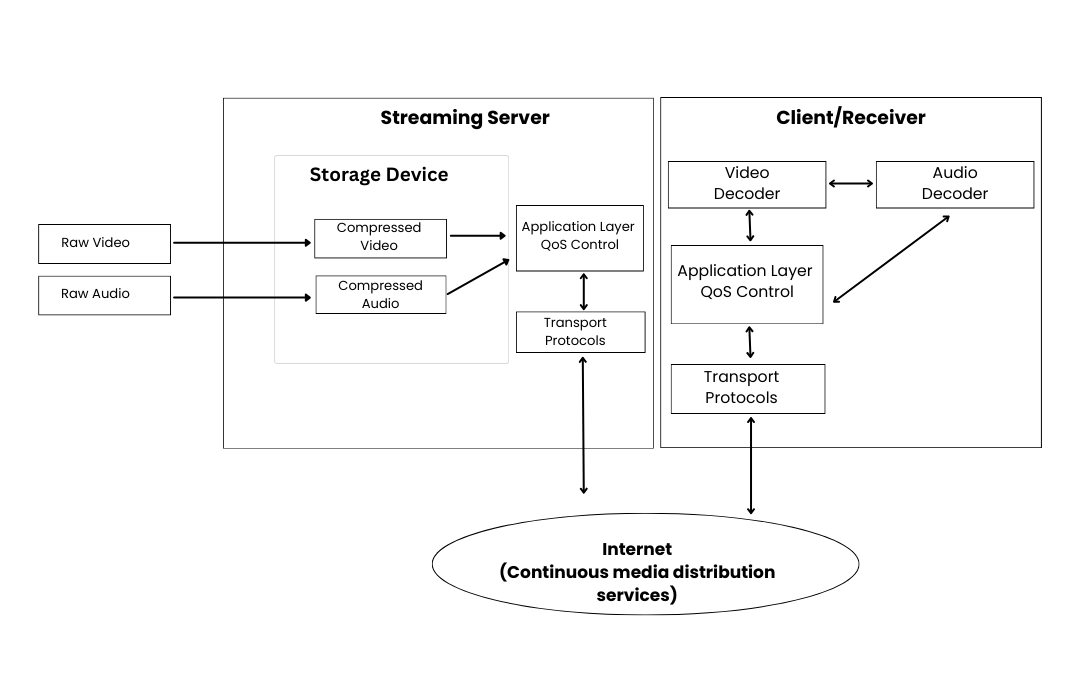A live streaming server is a specialized type of server that is designed to broadcast real-time video and audio content over the internet. It plays a crucial role in enabling live streaming technology, which has become popular for events like sports, concerts, conferences, and personal broadcasting on platforms like Twitch or YouTube Live.
What is a video streaming server?
A streaming server is a specialized server that handles the delivery of video and audio content to viewers over the internet. To offer quality streaming, streaming servers process multimedia data under time constraints. This prevents any jerkiness or hindrance in the video delivery and playback.
A streaming server typically has 3 subsystems:
Communicator – It involves application layer and transport protocols which are implemented on the server. In other words, it manages the network communication between streaming servers and clients. It handles how the data flows over the network, ensuring smooth and uninterrupted streaming. It manages streaming protocols like HTTP, RTSP and aspects like buffering and bandwidth optimization.
Operating system – The OS provides the necessary environment for all the processes and applications to run within the server. It manages the server’s hardware resources such as memory, CPU. It includes optimizations to handle high volume of data throughput and connections which are common while streaming.
Storage System – Here the actual streamable content is stored. It needs to ensure fast and reliable access to the media files. It has an effective caching mechanism and redundancy to ensure high performance and availability.
Video streaming architecture
Video Compression
Video compression is crucial in streaming technology. It reduces the size of the video files, making them easier to transmit over the internet. Compression is achieved using codecs (encoder/decoder). Common codecs include H.264, H.265, and VP9. The process involves two key steps:
- Encoding – It compresses the video file, reducing its size without significantly compromising quality. This is done through techniques like inter-frame compression, which only stores changes from one frame to the next rather than entire frames.
- Decoding – On the user’s end, the compressed video is decompressed by the decoder to be viewed. Efficient compression balances file size reduction and video quality.
VdoCipher empowers course creators, event organizers, and broadcasters with expert live video streaming, ensuring smooth playback globally.
Application-Layer QoS Control
Quality of Service (QoS) at the application layer ensures a smooth streaming experience. It involves:
- Adaptive Bitrate Streaming – Dynamically adjusting video quality based on the user’s internet speed to prevent buffering.
- Network Monitoring – Continuously monitoring network conditions to adapt the stream accordingly.
- Resource Allocation – Prioritizing network resources for critical components of the stream to maintain quality.
Continuous Media Distribution Services
This section refers to the services that enable continuous, uninterrupted delivery of streaming content. Key elements include:
- Content Delivery Networks (CDNs) – Distributed network of servers that deliver content efficiently by caching it closer to the end-user.
- Load Balancing – Distributing network traffic across multiple servers to ensure stability and reduce latency.
Redundancy – Implementing backup systems to avoid service interruptions.
Streaming Servers
Streaming servers are specialized servers designed to efficiently deliver streaming content. They handle:
- Client Requests – Managing simultaneous requests from a vast number of users.
- Data Transmission – Utilizing protocols like RTMP (Real-Time Messaging Protocol) or HLS (HTTP Live Streaming) for efficient data transmission.
- Storage and Retrieval – Storing large volumes of media and retrieving them quickly upon request.
Media Synchronization Mechanisms
Synchronization ensures the audio and video tracks play in harmony. This includes:
- Lip Sync – Matching audio with the corresponding video (especially speech).
- Frame Synchronization – Ensuring frames are displayed at the correct rate.
- Buffer Management – Balancing buffers to avoid delays between audio and video.
Types of streaming servers
Streaming servers are categorized based on the content they deliver, functionality, and technology they use.
Live streaming servers – These servers broadcast live events in real-time. The process includes live audio and video feeds, encoding and then transmitting over the internet.
On-demand streaming servers – These servers store pre-recorded videos and media files and deliver upon request from the user. The services include movie streaming, playing recorded sessions, podcasts and more.
Audio streaming servers – These servers are designed for audio content (streaming music, podcasts, radio broadcasts)
Peer-to-Peer (P2P) Streaming Servers – Unlike traditional client-server approach, in P2P streaming, a peer simultaneously acts as a client and a server. A video can be downloaded from a set of peers and simultaneously uploaded to another peer set. This significantly reduces the bandwidth requirement.
Private Streaming Servers – Private servers have restricted access and more security. They are primarily used within organizations for training, webinars, and internal communications.
Functionality of a live streaming server
Capture and Encode – The server receives live video and audio feeds, typically from a camera or a computer. These feeds are then encoded, meaning they are compressed into a digital format suitable for transmission over the internet. Common encoding formats include H.264 for video and AAC for audio.
Transcoding – Some servers also transcode the stream, which means converting the original encoded content into multiple formats or qualities. This is crucial for adaptive streaming, where the quality of the stream adjusts based on the viewer’s bandwidth.
Delivery – After encoding, the server distributes the stream to viewers. This can be done directly (in smaller setups) or via a Content Delivery Network (CDN) for larger audiences to reduce latency and buffering.
Live streaming server protocols and technologies
Streaming protocol is a set of rules governing how data travels from one device to another. For online video delivery, both streaming protocols and HTTP-based protocols are used. For example, RTMP offers fast video delivery while HTTP protocols optimize viewing experience.
RTMP
Adobe defines RTMP as “Adobe’s Real Time Messaging Protocol (RTMP) provides a bidirectional message multiplex service over a reliable stream transport, such as TCP [RFC0793], intended to carry parallel streams of video, audio, and data messages, with associated timing information, between a pair of communicating peers.”
Flash player and RTMP were the main players for live streaming for many years. Even with the decline of Flash, still, RTMP encoders are the most used streaming protocol for ingest. Mostly, live video streams are initially encoded and later transcoded using a streaming server for content delivery to various devices and players. The most common live streaming workflows include RTMP and HLS.
HLS
Developed by Apple, HLS streaming is a widely used streaming protocol. It was originally used both for live streaming and on-demand video content over HTTP to iOS devices. Now, it is platform agnostic.
HLS is also an adaptive bitrate streaming protocol, meaning the video quality is adjusted in real-time as per the viewer’s internet speed. Initially, compared to RTMP, HLS had higher latency but later Apple introduced low-latency HLS that reduced latency to 2 seconds or less.
Supported Codecs and Formats:
- Video Codecs – H.264, H.265/HEVC (High Efficiency Video Coding).
- Audio Codecs – AAC (Advanced Audio Coding), MP3.
- Transport/Package Format – MPEG-2 TS (Transport Stream)
MPEG-DASH
Developed by Moving Pictures Expert Group (MPEG), MPEG-DASH is an alternative to HLS. Being open-source, it is highly customizable for audio and video codecs. It supports adaptive bitrate (ABR) protocol, delivering best quality video as per the viewer’s network connectivity.
MPEG-DASH allows use of any encoding standard unlike HLS that requires H.264 or H.265. Also, iOS devices cannot play video that is delivered over MPEG-DASH.
Similar to other streaming protocols, MPEG-DASH breaks video into small chunks that are transmitted over HTTP.
- Chunked Transfer Encoding – In this method, as soon as the segment of a video chunk is ready, it is sent to the client. In other protocols, there is a wait time for the entire segment to be encoded and packaged before sending. This approach significantly reduces latency and makes MPEG-DASH an ideal streaming protocol for live streaming.
- No minimum queue required – DASH doesn’t require a minimum number of segments to be queued before playback can start. This lowers latency because the video can begin playing as soon as enough data has been received, rather than waiting for a larger buffer to fill up.
- Codec Agnostics – MPEG-DASH is not tied to any specific video codec. A codec is a method for encoding and decoding video and audio data.
| Video Codec | Advantages | Drawbacks |
| H.264/AVC | Extensive compatibility across devices. |
Not the forefront of compression technologies.
|
| H.265/HEVC | Capable of 8K video resolution support. |
Encoding process can be up to four times slower than H.264.
|
| AV1 | Cutting-edge and open-source codec. |
Wide-scale support still pending.
|
| VP9 | Predecessor to AV1 without licensing fees. | Superseded by AV1. |
| H.266/VVC | Designed as an improvement over H.265. |
Inherits the royalty challenges of H.265.
|
Setting up a live streaming server
Hardware requirements
Processing power – live streaming is a highly resource intensive process. To As the number of concurrent streams and resolution increases, the CPU consumption for video encoding in real-time increases. We then need powerful CPU.
Storage – To ensure smooth operation, adequate storage and RAM is required. SSDs are preferred for faster data access.
Network interface – The server should be highly reliable and have robust internet connectivity for faster data transmission.
Software and Platform selection
Operating System – Choose between Windows Server, Linux, or other server operating systems based on compatibility with your streaming software and your own expertise.
Streaming Software – Open-source software like OBS Studio (for encoding) and NGINX with RTMP module (for server-side streaming). If you want know more about how to use obs studio, you can check the blog linked.
Codec Selection – Choose the right codec (e.g., H.264, H.265) based on a balance between quality and required bandwidth.
Server configuration and optimization
Network Configuration – Ensure that your network settings, including firewalls and port forwarding, are configured to allow uninterrupted streaming.
Software Configuration – Set up your streaming software. This involves configuring input sources (e.g., cameras, microphones). Setting up encoding options, including resolution, bitrate, and frame rate.
Configuring the streaming protocol (e.g., RTMP, HLS) and stream destinations (e.g., YouTube, Twitch, or a CDN).
Security – Implement security measures like encryption, access controls, and, if necessary, a VPN.
Testing: Before going live, conduct thorough testing to ensure everything works seamlessly. Check for stream quality, latency, and stability.
Optimization – Based on the testing, optimize settings like bitrate and encoding options for the best performance. Monitor CPU and memory usage to ensure the server is not overburdened.
Scaling – Plan for scalability, especially if you expect a large number of viewers. This might involve setting up load balancing or using a CDN.
Network considerations for live streaming
Bandwidth consumption
Live video streaming consumes significantly higher bandwidth. The requirement depends on the stream’s resolution, compression and frame rate. For example, streaming at 1080p might require 4-5Mbps, while a 4k stream might need upwards of 20Mbps. Make sure the network handles maximum bandwidth requirement without hindering simultaneous internet usage.
Upload speed
The upload speed determines how much data you can send to the internet per second. Higher upload speeds allow for higher quality video and audio streams.
With a faster upload speed, you can stream at higher resolutions (like 1080p or 4K) and higher bitrates, which translates to clearer, more detailed images and better sound quality.
Latency
Low latency is essential for real-time interaction between the streamer and the audience. In interactive streams, like Q&A sessions, gaming, auctions, or live events, high latency can disrupt the flow of conversation and engagement. The closer the stream is to real-time, the more engaged the audience can be, as they can react to and interact with the content as it happens.
Content Delivery Network (CDN)
For reaching a wider audience, especially geographically dispersed, a CDN can distribute the load, reduce latency, and improve the overall viewing experience. CDNs work by caching the stream on multiple servers located closer to different viewers. During high-traffic events, a CDN can distribute the load among multiple servers, preventing any single server from becoming overwhelmed. This ensures consistent streaming quality even when viewer numbers are high.
FAQs
Which server is best for live streaming?
The best server for your live streaming website depends on your specific needs, such as the number of viewers, stream quality, and budget. Cloud-based solutions like Amazon Web Services (AWS) and Google Cloud Platform (GCP) are also highly regarded for their scalability and reliability.
What is a streaming server?
A streaming server is a specialized server that distributes audio and video content to viewers over the internet. Unlike traditional download servers, streaming servers allow users to view content in real-time without downloading the entire file first. They are optimized to manage large, continuous data flows essential for streaming media.
What is streaming server price?
The cost of a streaming server can vary widely. A basic setup using open-source software like OBS Studio can be relatively inexpensive, mainly requiring a capable computer and internet connection. Professional-grade servers can cost from a few hundred to several thousand dollars, depending on the features and scale. Cloud-based solutions often operate on a pay-as-you-go model, where costs depend on usage and bandwidth.
Supercharge Your Business with Videos
At VdoCipher we maintain the strongest content protection for videos. We also deliver the best viewer experience with brand friendly customisations. We'd love to hear from you, and help boost your video streaming business.


Jyoti began her career as a software engineer in HCL with UNHCR as a client. She started evolving her technical and documentation writing skills to become a full-time Content Marketer at VdoCipher.

